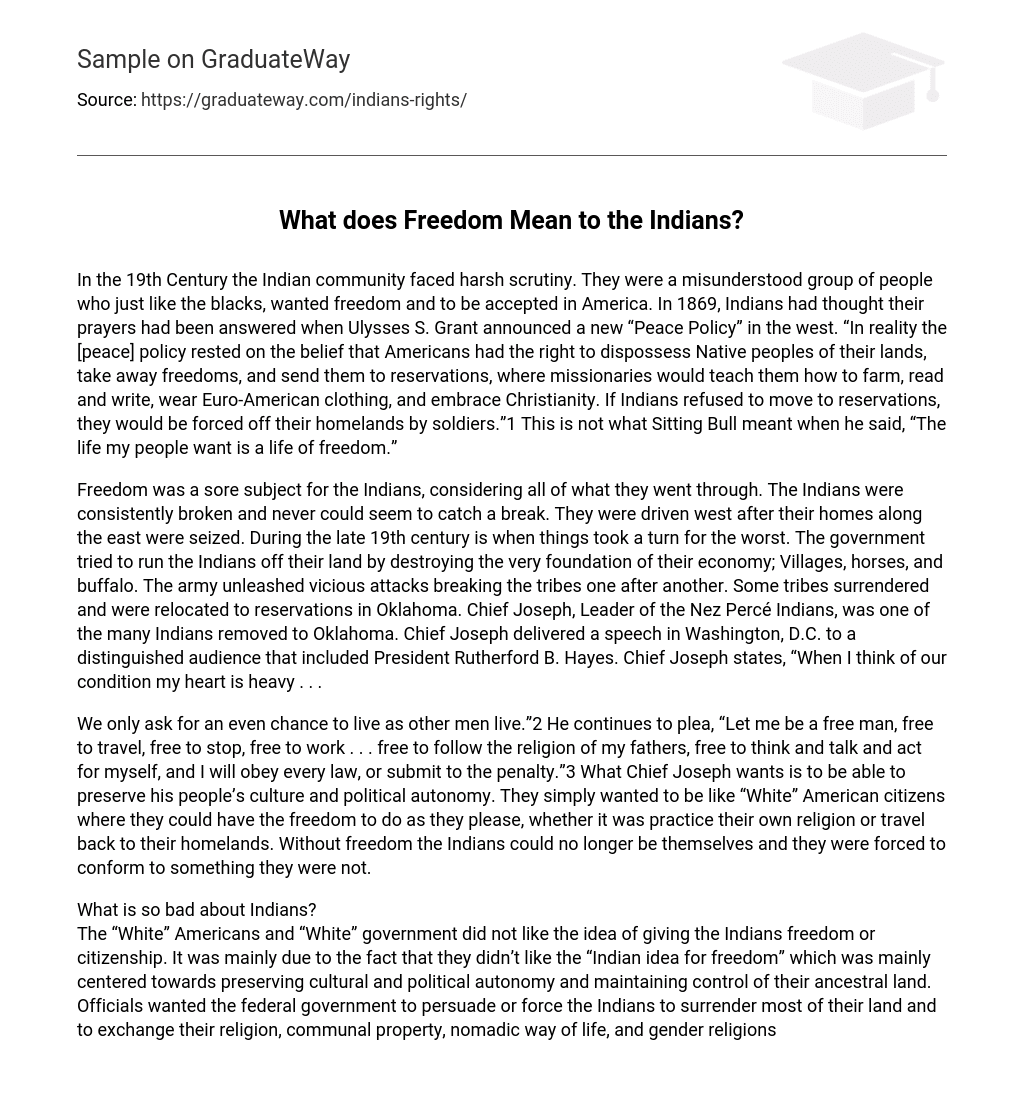During the 19th Century, both the Indian and black communities in America faced similar scrutiny and shared a desire for freedom and acceptance. In 1869, Indians believed that their prayers had been answered when Ulysses S. Grant announced a new “Peace Policy” for the western region. However, this policy actually aimed to dispossess Native peoples of their lands and freedoms. It involved relocating them to reservations where missionaries would teach them farming, reading, writing, wearing Euro-American clothing, and Christianity. Any resistance from Indians would lead to forced removal by soldiers. Sitting Bull disagreed with this policy as it did not align with his vision for his people’s ideal life.
The Native Americans encountered numerous challenges and experienced a significant loss of freedom, enduring continuous hardships and defeats without respite. They were forced to relocate westward after being displaced from their homes in the east. In the late 19th century, the situation worsened as the government attempted to drive them off their land by destroying their economic foundations such as villages, horses, and buffalo. The army systematically dismantled each tribe through merciless attacks. Some tribes surrendered and were relocated to reservations in Oklahoma, including Chief Joseph – leader of the Nez Percé Indians. Chief Joseph expressed his deep sorrow while contemplating their predicament during a speech delivered in Washington D.C., where President Rutherford B. Hayes was among the distinguished audience: “When I think of our condition…”
Chief Joseph is requesting a fair chance to live like other individuals, desiring freedom to travel, work, practice his religion, and exercise independent thoughts and actions. He pledges to adhere to the law while aiming to preserve his people’s culture and political autonomy. The Native Americans seek the same liberties as “White” American citizens, allowing them to freely practice their own religion and return home. Devoid of freedom, they are forced to conform to a lifestyle that contradicts their genuine identity.
What is the issue with Indians?
The “White” Americans and government were opposed to granting Indians freedom or citizenship. This was primarily because they disagreed with the Indian concept of freedom, which focused on preserving cultural and political autonomy, as well as maintaining control over their ancestral land. Officials sought to pressure or compel the Indians to give up a significant portion of their land and abandon their religion, communal property, nomadic lifestyle, and gender roles in favor of practicing Christianity, owning private property, and engaging in small-scale farming on reservations, with men working in the fields and women tending to the home.
4 Whites held a dislike for the Indians’ lifestyle and forbade them from becoming citizens unless they abandoned their Indian customs and embraced the American way of life. The government enacted the “Dawes Act,” which aimed to return land to the Indians on the condition that they assimilated into “civilized life.” Numerous additional laws and treaties were introduced to grant Indians citizenship, but these provisions only applied if they abandoned their tribal lifestyle.
Both Sitting Bull and Chief Joseph shared a common desire for freedom for their people, and were prepared to take life-threatening risks in order to achieve it. However, the Indians could not attain the desired freedom despite being offered American citizenship, as this would mean giving up their traditional way of life.
To attain genuine freedom, the Indians had to relinquish their former lifestyle and embrace a fresh existence. Mere assimilation into mainstream American society did not satisfy them; instead, they yearned for complete immersion in the American dream. They sought to live in harmony and pursue their own aspirations without being subjected to judgment from individuals who differed from them.
Bibliography
Foner, Eric, “An Indian’s View of Indian Affairs”, Voices of Freedom: A Documentary History, Vol. 2, 3rd edition, edited by Eric Foner, 28. New York: W. W. Norton & Company, Inc., 2011
Foner, Eric, Give Me Liberty: An American History, Vol. 2, 3rd Edition. New York: W. W. Norton & Company, Inc., 2011
“President Grant advances “Peace Policy” with tribes – Timeline – Native Voices.” National Library of Medicine – National Institutes of Health. http://www.nlm.nih.gov/nativevoices/timeline/342.html (accessed September 24, 2013).
Trafzer, Clifford, American Indians/ American Presidents: A History, New York: HarperCollins Publishers, 2009





